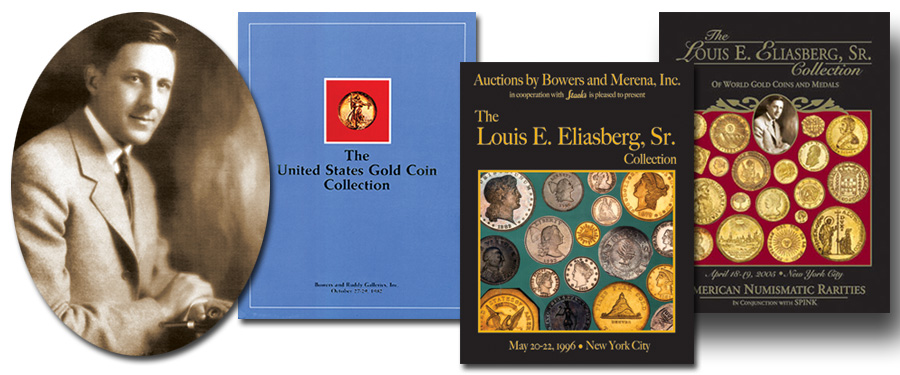
Remembering Louis E. Eliasberg
For this week’s blog I revisited some comments I made back in 2006, adding updates. I had the pleasure of knowing Louis E. Eliasberg, Sr., the famous Baltimore numismatist who from 1925 to 1950 set about building a fine collection, eventually changing his goal to the ultimate: to obtain one of each date and mint and major type of United States coin ever struck. By 1950 he accomplished what many thought was impossible—and owned everything from a 1793 copper half cent to a 1933 gold double eagle. The very last coin he acquired for the collection was the unique 1873 Without Arrows dime.
In the summer of 1975 I was his guest for a week in Baltimore, reviewing his collection and discussing aspects of it with him. He wanted me to review the grades of the coins and discuss values. I was honored to have been selected to do so. Each day we would leave the bank vault at noon and have lunch at the Center Club. Every evening I would have dinner with him and his wife.
Later, after his passing (in 1976), his two sons, Louis, Jr., and Richard, who had inherited the incredible collection, asked me to make proposals to present the coins at auction. Each had received a share of the holdings. I did, and the rest is part of numismatic history. Coins that cost Mr. Eliasberg less than $400,000 realized over $40,000,000! The latter figure does not even include the extra millions realized when the Eliasberg gold coins of the world (other than the United States) were auctioned by American Numismatic Rarities in 2005. I was as proud as can be, to be part of the 2005 sale, the arrangements for which were handled by Chris Karstedt and the cataloging for which was by staffers John Kraljevich, Frank Van Valen, and John Pack.
By the way, Richard Eliasberg remains the best of friends with me and Chris Karstedt today. Every now and again he, sometimes with his lovely wife Hilde, visits us in New Hampshire.
Louis Eliasberg was best known for the collection he built and often shared his love of the hobby with others, exhibiting it in many places, including at banks and even at the Philadelphia Mint, as I will discuss later. In addition, he was a consummate student of American financial history. If asked, he could have stood on a proverbial soapbox and regaled his listeners with stories of coins and paper money and how they were used over the years.
In 1976 the Eliasberg Collection was shown at the United States Mint for just four months. In that short time it attracted 1,500,000 viewers! That is right: 1,500,000! The arrangements for this exhibit were made by Harvey Stack in conjunction with Vladimir and Elvira Clain-Stefanelli, curators of the National Numismatic Collection at the Smithsonian. The National Numismatic Collection had been loaned (not gifted) to the Smithsonian by the Philadelphia Mint in 1923, to make it possible for the public to see and enjoy it more easily. For the nation’s bicentennial celebration in 1976 the Mint wanted it back. What to do? As noted, Harvey arranged for the Eliasberg Collection to be shown at the Mint instead—drawing far more visitors than had ever seen the coins at the Smithsonian in any comparable short period.
Going back a year earlier, on November 9, 1975, Louis E. Eliasberg addressed a group of numismatists and others at the Evergreen House, a mansion on North Charles Street, Baltimore. Now the property of The Johns Hopkins University, generations earlier it had been the home of T. Harrison Garrett and, later, his son John Work Garrett and his wife. The Garretts formed the greatest of all early coin collections (which I and staff members had the opportunity to catalog and present at auction from 1979 to 1981).
Eliasberg’s 1975 talk was titled, "Why, When, and How I Assembled the Most Complete Collection of United States Coins." Excerpts:
"If you are a numismatist or coin collector, I hope you will derive the degree of pleasure and happiness I have in assembling my collection. In making your purchases you should buy them through reputable dealers. If you invest any significant portion of your assets in rare coins, be sure that you are thoroughly familiar with all aspects of such an operation."
More from 1975:
"The profitability of collecting coins can be measured in part by my own experience.… Based on our recent appraisal [1975] I find that I have averaged a minimum return of over 11.9% a year on the original cost."
Regarding Evergreen House, not long ago our final sale of the D. Brent Pogue Collection was held at Evergreen House. It is interesting how persons, places, and things can weave together!
Regarding pleasure and happiness, it is available as much as ever. Today in June 2019 all that is needed is to learn about and enjoy the art, science, and romance of numismatics. These are the ultimate keys to longevity. Other aspects such as the price of silver and gold and the latest grade assigned by PCGS or NGC are unimportant by comparison.
Enjoy!





